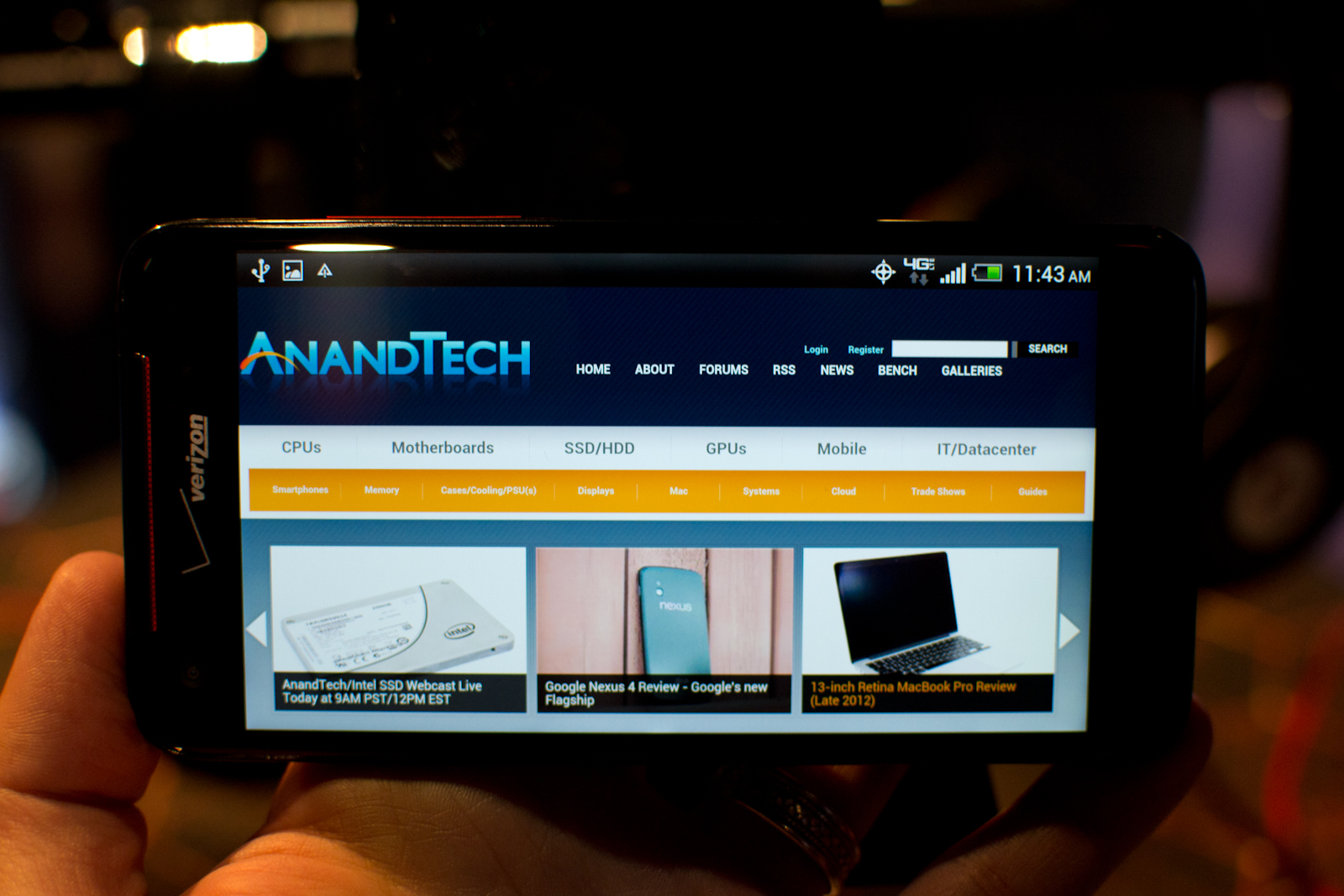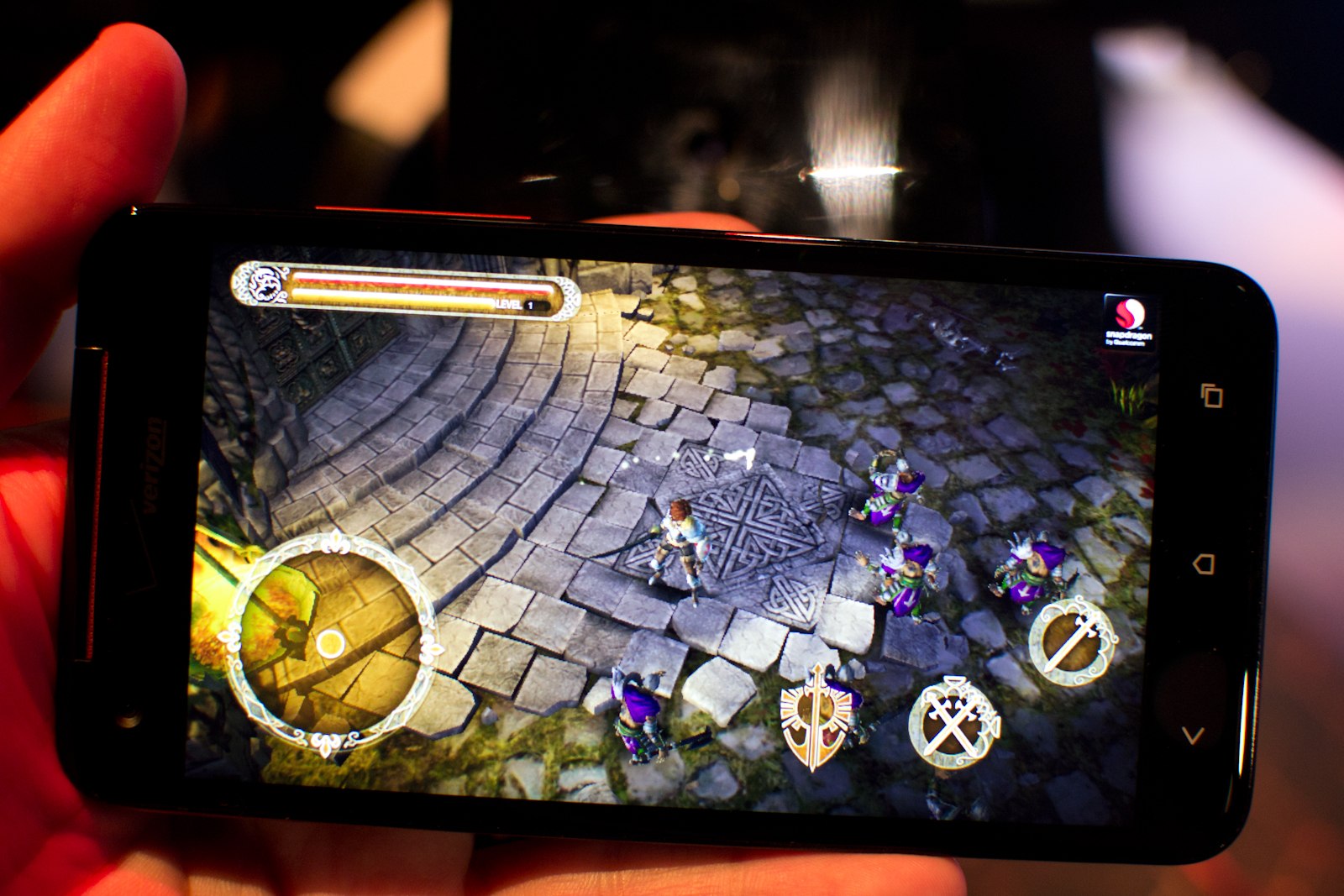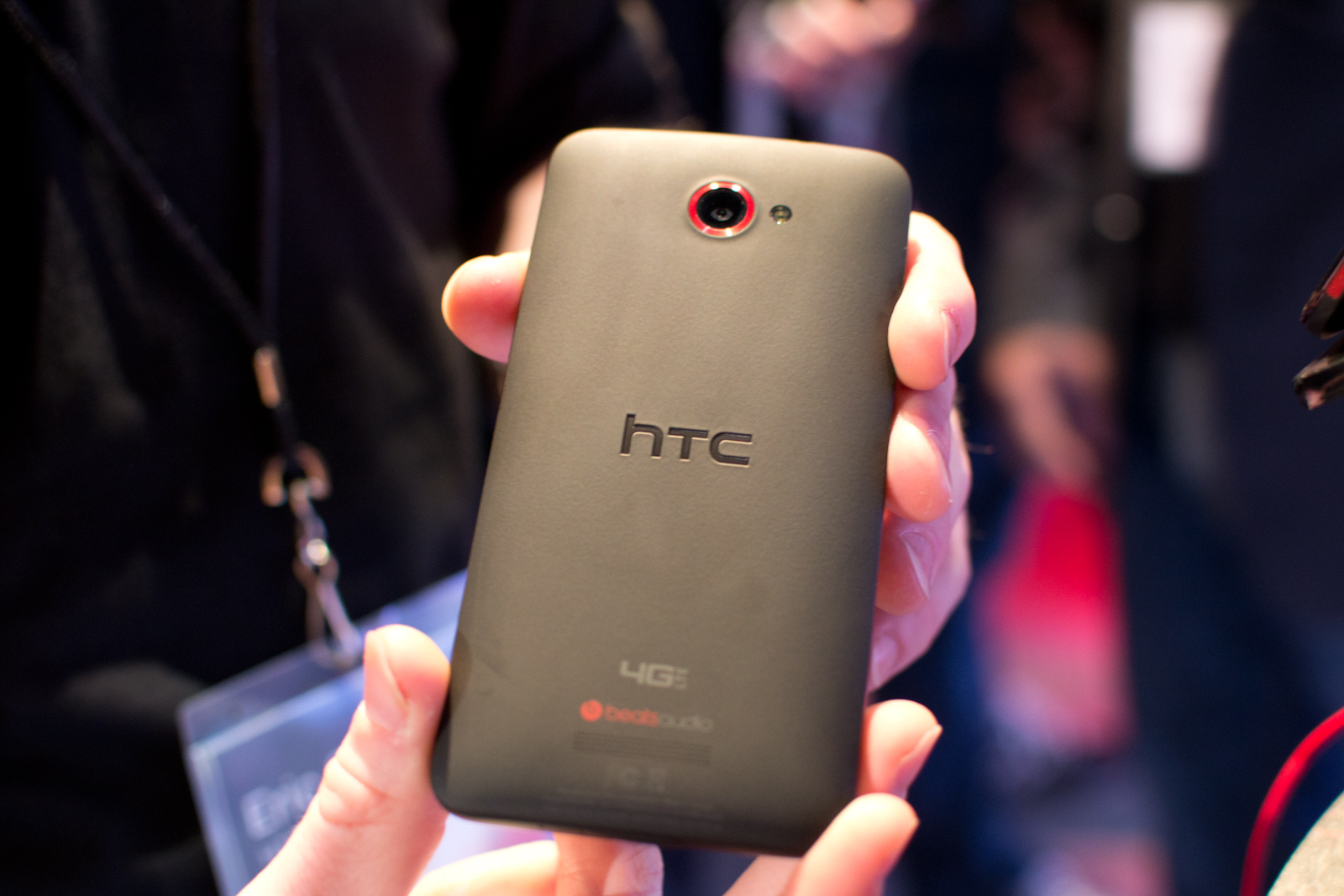HTC Droid DNA Hands-On
by Jason Inofuentes on November 13, 2012 12:22 PM EST- Posted in
- Smartphones
- Snapdragon
- HTC
- Verizon
- Mobile
- APQ8064
- droid dna
Today’s HTC Droid DNA announcement brings a few big advancements over the HTC One X that never made it to Verizon's line-up. We'll start our hands-on discussion with the most obvious change: the screen.
The Display

The rapid advance of screen technology means that we're just a year removed from the arrival of 720p displays, and just two years removed from WVGA being the defacto resolution. Today we see the efforts of Sharp’s display team come to fruition with a seemingly uncompromised 5" 1080p display. The pixel density is an unchallenged 440 ppi, and it seems to retain the brightness and fidelity of its predecessors, most recently seen in the HTC One X.

Hands-on events aren’t the place for detailed analysis, the time is too short, and the venues to cramped to pull out a colorimeter. What I will say is that the display is easy on the eyes and offers such a glut of pixels that no amount of squinting allowed me to discern. Viewing angles seemed good, with no distortion noted, and colors were bright without being oversaturated. So, at first glance, a somewhat expected excellent for the display. Here’s the thing: do we want a 1080p 5” display? At this pixel density, we would be approaching an angular subtense of two thirds of a degree. That's well below the human ability to discern at twelve inches. So is the likely battery hit worth the improved pixel density? We'll have to wait and see.
The Design

The great display is surrounded by narrow bezels all around, and the result is a body that is just 6.2 mm longer than the One X, despite the larger screen, and less than a millimeter wider. Gorilla Glass 2 is used and actually extends across the entire face of the device and forms part of the edge of the handset, a surefire sign of confidence in the strength of the glass. The effect is to make the front glass and back seem fused into one solid piece. Accent grills adorn the sides of the device, in the bright red we’ve come to expect from HTC phones on VZW. The back is a softly curving single expanse of matte black, with the HTC logo etched and inlayed in silver. An LTE logo, Beats Audio logo and the single speaker grill grace the bottom of the back, and the 8MP rear-shooter sits at the top. One particularly unique feature on the back is a concealed status LED to the left of the camera lens. When the phone is face down and a notification is received, the LED will blink to alert the user. The LED is also used to alert self-shooters when the shutter will release.

At nearly a centimeter at its thickest point, this is not the thinnest phone; but the way the back tapers down to the edge gives it an excellent in the hand feel, and makes it feel thinner than its specifications would indicate. Despite deviations from the One series design language, the solidity that defines that lineage can be seen here.
| Physical Comparison | ||||
| HTC Droid DNA | HTC One X (AT&T) | Samsung Galaxy S 3 (USA) | LG Nexus 4 | |
| Height | 141 mm (5.55") | 134.8 mm (5.31" ) | 136.6 mm (5.38") | 133.9 mm (5.27") |
| Width | 70.5 mm (2.78") | 69.9 mm (2.75") | 70.6 mm (2.78") | 68.7 mm (2.7") |
| Depth | 9.73 mm (0.38") | 8.9 mm (0.35") | 8.6 mm (0.34") | 9.1 mm (0.36") |
| Weight | 142 g (5.01 oz) | 129 g (4.6 oz) | 133 g (4.7 oz) | 139 g |
| CPU | 1.5 GHz APQ8064 (Quad Core Krait) | 1.5 GHz MSM8960 (Dual Core Krait) | 1.5 GHz MSM8960 (Dual Core Krait) | 1.5 GHz APQ8064 (Quad Core Krait) |
| GPU | Adreno 320 | Adreno 225 | Adreno 225 | Adreno 320 |
| RAM | 2 GB LPDDR2 | 1 GB LPDDR2 | 2 GB LPDDR2 | 2 GB LPDDR2 |
| NAND | 16 GB NAND | 16 GB NAND | 16/32 GB NAND with up to 64 GB microSDXC | 8/16 GB NAND |
| Camera | 8 MP with AF/LED Flash, 2.1MP front facing | 8 MP with AF/LED Flash, 1.3 MP front facing | 8 MP with LED Flash + 1.9 MP front facing | 8 MP with AF/LED Flash, 1.3 MP front facing |
| Screen | 5" 1920 x 1080 LCD-TFT | 4.7" 1280x720 LCD-TFT | 4.8" 1280x720 HD SAMOLED | 4.7" 1280x768 HD IPS+ LCD |
| Battery | Internal 7.47 Whr | Internal 6.66 Whr | Removable 7.98 Whr | Internal 8.0 Whr |
The Camera
Cameras, like displays before them, were long ignored as just value adds, and not features that must be optimized and perfected. It’s really exciting to see manufacturer’s compete for the best phone camera and not just through software trickery. HTC’s approach is, perhaps, the most traditional, and that is to provide an optical package that mimics the higher-end discrete glass you’d find on a proper SLR. The same f/2.0 28mm optics package is used here, as in the One X, and most likely the same sensor is in play. The ImageChip ISP remains a feature, and the software (now called Sense 4+) has a few additions to improve usability. It’ll be interesting to see how Sense 4+ and Android 4.2’s new camera software will play together, but for now the camera seems intuitive and the results look to match that of the One X.
The front-camera from the HTC WIndows Phone 8X finds a home here, bringing its f/2.0 optics, ultra-wide angles and 2.1MP sensor, which shoots 1080p video.
The SoC
Obviously, we’ve spent a little time with this particular SoC, recently. UI performance was smooth, and hard to trip up, even with the graphical flourishes HTC favors. The home screen carousel is no more, but cycling through home screens remains a wrap around affair and a second tap on the home button still brings an overview of all your home screens. All those flourishes render fluidly, and hopping in an out of apps and the app drawer, I didn't notice any particular hiccups. Performance should be excellent in our typical tests, based on SoC alone, but software is always a key component to the experience, and it'll be interesting to see how this S4 Pro equipped handset differs from the Nexus 4 and LG Optimus G.
The Audio
HTC has been focusing on handset audio for sometime, including their investment in and use of Beats Audio's DSP algorithms. Beats Audio remains, and there’s even a VZW tie-in with the Beats Pill, a portable Bluetooth speaker. Added to the mix is a dedicated 2.55v headphone amp, which should be able to drive even the most high-end cans. Sound quality should be improved in all headphones, and they were certainly able to power my modest earbuds well. No specifics were provided, but a dedicated amp for the rear speaker should give audio a boost there, as well. This sort of focus on audio quality is always nice to see, and we’ll be excited to put the DNA through its paces to see how it stacks up.

















54 Comments
View All Comments
ratbert1 - Tuesday, November 13, 2012 - link
The article states the DNA is 15mm longer than the OneX, but the chart shows 6.2mm(.24") difference. Which is it?JasonInofuentes - Tuesday, November 13, 2012 - link
Fixed. Sorry, fuzzy math while on a train. It's just 6.2 mm longer, though we didn't have on on hand to compare.willywill - Tuesday, November 13, 2012 - link
Anybody know where i can find that APK for that clock widget, i know its out there alreadySkiddywinks - Tuesday, November 13, 2012 - link
Searching the Play Store for "Sense Analog Clock" gets you about as close as I know exists. None of those fancy textured looking digits etc though. Sorry I couldn't be of more help.kg4icg - Wednesday, November 14, 2012 - link
Beautiful widgetsaryonoco - Tuesday, November 13, 2012 - link
With all the quality hardware that HTC is producing, I just hope their finances improve and they can bounce back.I just don't understand why they aren't doing better. The One series was a solid line up and I was really expecting them to start generating good margins on them, but apparently the only two companies which are able to profit from this massive smartphone explosion are Apple and Samsung. Surely there is enough room in this market for more people to turn decent (if not Apple-like) profits.
My first real smartphone was an HTC (Symbian doesn't count) so I'll always have a soft spot for them. I hope they can bounce back.
Chugworth - Tuesday, November 13, 2012 - link
My first real smartphone was an HTC as well. Of course back then, HTC wasn't a well-known brand name, so the phone was designed by HTC, manufactured (or something) by UTStarcom, and finally branded the Verizon XV6700.I would have liked to stick with HTC, but the problem for me has always been timing. They never have what I want when I want it. For instance, if you remember back when the Motorola Droid was first released, HTC also released the inferior Droid Eris. I went with the Motorola Droid. I certainly wasn't ready to switch from the Droid when the HTC Incredible was released. And when Thunderbolt was released, I was holding off for the first LTE phone with a dual-core processor. (I ended up skipping the Bionic because by then, if I remember right, there were already rumors of the Galaxy Nexus (my current phone)).
I will say though, that the Droid DNA looks interesting. Tempting even. But... I just don't think I'm ready to move away from my Galaxy Nexus.
pixelstuff - Tuesday, November 13, 2012 - link
That's funny. I have the exact same track record. Motorola Droid then Samsung Galaxy Nexus.Peanutsrevenge - Wednesday, November 14, 2012 - link
Both my smartphones have been HTCs because their timing has been spot on for me.HTC Hero initially, then Sensation (current). I was going to get the SII but it was out of stock so I went for the Sensation which was also top of the list.
Not ready to upgrade yet (4.2 ROMs expected within a week), but even if I was ready, I'm not sure I'd be willing to stick with HTC due to their slow updates and source releases.
This looks amazing, but I read there's no removable battery or SD slot, which I still want personally (or what google did with the nexus 4 and make the battery replaceable, but only when it's failing rather than during the day.
Only the SIII i9305 grabs my attention at the moment, but with A15 not looking to eat batteries alive, now seems to be suspect time to upgrade.
lmcd - Friday, November 23, 2012 - link
Krait cores are considered even with A15 cores, or really close to it, so I wouldn't consider an SIII a bad buy now unless you're on Verizon, where the Razr HD and its bigger battery seem a bit more appealing (unless you're the battery-swapping type, though I would never feel comfortable regularly opening the SIII's back).